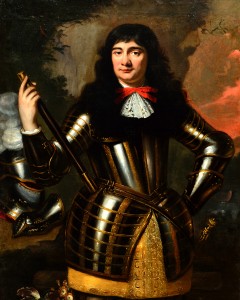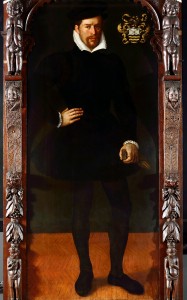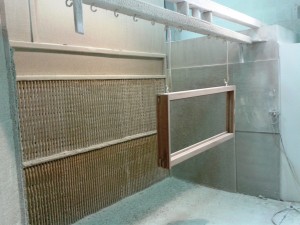 There is a very interesting group of portraits in The Library at Combermere Abbey, about which, unfortunately, we know very little indeed. Before Sir Kenneth Crossley bought the house and its estate in 1919, the last of the Viscounts Combermere to live at the house dispersed all the contents in a huge three-day sale (click here to read about the auction), and to the best of our knowledge there was absolutely nothing in the house when Sir Kenneth took possession.
There is a very interesting group of portraits in The Library at Combermere Abbey, about which, unfortunately, we know very little indeed. Before Sir Kenneth Crossley bought the house and its estate in 1919, the last of the Viscounts Combermere to live at the house dispersed all the contents in a huge three-day sale (click here to read about the auction), and to the best of our knowledge there was absolutely nothing in the house when Sir Kenneth took possession.
It seems most likely that he purchased the portraits, and one criterion was that they were acquired specifically to fit the spaces on the Library wall which cried out for paintings, regardless of the subjects. The two portraits on canvas have been cut down and have additions top and bottom, which is a clue (not all were removed from their frames for restoration, so we cannot say if the width was reduced in all cases, but the others had part of the painted image showing on the sides of the stretchers).
There is no common denominator between them. All seem to be continental, and the one who is possibly of an Englishman – above and below – has no known association with the Abbey.
 In my opinion this gentleman looks older than he probably was when he stood for the portrait because of his fleshy face, but was probably only in his thirties. His complexion is slightly florid, indicating that he is perhaps a country gentleman.
In my opinion this gentleman looks older than he probably was when he stood for the portrait because of his fleshy face, but was probably only in his thirties. His complexion is slightly florid, indicating that he is perhaps a country gentleman.
He is wearing full battle armour from themed-Sixteenth century, plus or minus ten years either way – coloured in burnished black, and with elaborate gold panels.
This is very expensive armour (made for fighting on horseback, of course); far more elaborate and ostentatious than that which a mere chevalier would have worn, and it is as fine as that worn by King Charles I in his portraits. This man’s armour is as ostentatious and expensive as that worn by the Princes Charles and Rupert in the 1637 double portrait by Anthony Van Dyck. He is very definitely of the officer class, and a senior one at that.
 It is interesting to compare the gentleman in armour from Combermere with contemporary portraits of military figures. Above, James Butler, first Duke of Ormonde (school of Sir Peter Lely).
It is interesting to compare the gentleman in armour from Combermere with contemporary portraits of military figures. Above, James Butler, first Duke of Ormonde (school of Sir Peter Lely).
 James II while Duke of York, 1665, Sir Peter Lely
James II while Duke of York, 1665, Sir Peter Lely
 King Charles II after 1660 (after Sir Peter Lely)
King Charles II after 1660 (after Sir Peter Lely)
 King William II (school of Sir Peter Lely). These portraits of four very great and grand men all show them in armour of the very highest quality. There are similarities in the leather strap-work and the metal detailing on the armour (especially with that of the Duke of Ormonde). None though has anything like the magnificence of the Combermere gentleman’s gold skirt. Note that three out of the four are also holding staffs of office.
King William II (school of Sir Peter Lely). These portraits of four very great and grand men all show them in armour of the very highest quality. There are similarities in the leather strap-work and the metal detailing on the armour (especially with that of the Duke of Ormonde). None though has anything like the magnificence of the Combermere gentleman’s gold skirt. Note that three out of the four are also holding staffs of office.
The royal Princes Charles and Rupert in armour equalled in quality by that worn by our gentleman from the Combermere Abbey Library
Our man is wearing a far from elaborate lace cravat at his throat (unlike the more complex high lace collars usually worn by Royalist officers, in particular; it resembles one worn by the Royalist officer Marmaduke D-Arcy in his Civil War-era portrait), tied with a racy scarlet ribbon.
On his left hip is a sword with a fancy grip and pommel, both of which might be gilded. The scabbard is held by a brown belt which goes round his waist, and an attached strap which supports the scabbard. This is finely stitched. His protective skirt (or chausses), which takes the weight of the armour on his hips and helps protect his groin, is very finely wrought in gold thread. If this is real gold thread than it obviously a garment of very great value (and weight!).
He is wearing a gauntlet on his left hand, but his right hand is bare and is holding a rod or staff of office – much broader than a mere swagger stick – which is his mark of authority. It was probably made of ebony, topped and tailed in brass (or even gold). His other gauntlet sits on a table to his right, along with a helmet surmounted by a white plume.
 While this portrait was being conserved it was revealed that another painting had been added below and over-painted
While this portrait was being conserved it was revealed that another painting had been added below and over-painted
 The gentleman now stands in an herbaceous border, albeit one that is upside down
The gentleman now stands in an herbaceous border, albeit one that is upside down
The full length portrait of the man in armour was originally two thirds of its current length, though it is possible that the picture was full length originally and the lower portion was damaged. At some point the picture was extended downwards, with a new panel attached to the bottom of the existing picture.
Incredibly this new extension already had a rather high quality image on it already, as was revealed by x-rays. This painting was of flowers in an urn, on a shelf with one flower lying on the shelf – which now appears top left of this lower half of the painting, as the flower piece was attached upside down. The flower painting dates from the Seventeenth or Eighteenth century, so was later than the portrait. A smaller section from the flower picture had also been added to the top of the portrait.
It was then over-painted with the lower half of the body and the legs of the man in armour, against a dark brown background. The flower painting had been quite damaged before it was re-used (which is perhaps why it was re-used). The fillings of these damages did not show in the X-rays as they were made of gesso (chalk), whereas the whites in the flowers – being lead white – did show.
The question was what to do with these two images during the conservation process. To over-paint the flowers once more seemed a rather sad option, but the weight of paint on the man’s legs meant that fully restoring the flower painting was not viable. Had it been then there would have been an argument for removing the paint and fully restoring it, and then painting new ‘replica’ legs on the man in armour, on a replacement panel.
In fact the decision was made to remove the over-paint of the background and show the flowers, but to leave the legs – so that our man is now standing in a flowerbed, albeit an upside down flowerbed.
It is understanding that the portrait was the work of Gerrit von Honthorst, who was born in Utrecht in 1592, and died there in 1656. He was probably the son of Herman Gerritsz, who painted tapestry cartoons. He trained with Bloemaert, the leading local painter, before travelling to Rome. After returning to Utrecht in 1620, he began to specialise in portraiture, and was very fond of candle-light scenes.
Gerrit von Honthorst of Utrecht, almost certainly the painter of the portrait of the gentleman in armour
We know that he was working in London in 1628, in the court of King Charles I, and that he returned to The Hague in December of that year. He then was in the service of Prince Frederick Henry of Orange (died 1647), and was his favourite portrait painter. He also created a series of classical and historical pictures commissioned by King Christian IV of Denmark.
Honthorst’s chronology does not help us much with the identity of the sitter (and what is most surprising about this portrait is that there is no coat of arms or any inscription to indicate who this gentleman was).
He could have been an Englishman, painted in 1628, or he could have been an English Royalist painted in exile during The Commonwealth. The law of averages suggests that he was continental however; the over-riding piece of evidence is the very high status of his armour, which suggests that he was not English – because any Englishman as wealthy as he would be recognisable to us. Further research is needed, and we are hoping that the National Portrait Gallery will be able to assist us.
In terms of quality the best painting in this group is the one of Andreas Gail (above, and detail below). What we see is a stern-looking gentleman of some wealth, who is very certain of his position in society. Gaill (or von Gaill) was born in Cologne in 1526 and studied to be an advocate in his home town, as well as studying in Orleans, Leuven, and Bologna.
In 1558 he was appointed to the Imperial Chamber Court, and from 1569 onwards, he served on the Aulic Council in Vienna. Just prior to his death in 1587 he was Chancellor to the Elector of Cologne. He is remembered as a great jurist and man of law. His 1578 work Practicae observationes ad processum iudiciarium imperialis camerae was the first systematic compilation of Chamber Court jurisprudence, which exerted a great influence on the practice of law in the Holy Roman Empire, and served as a template for most later German compilations of court decisions.
In the Combermere portrait his profession is expressed by the letter in his right hand and the folded document in his left. Aged perhaps in his fifties (he was sixty one when he died), he wears a felt or fur cap, with an expensive fur coat or cape over his shoulders. The rest of his clothing is a very sober black, but he has an exquisitely-creased ruff at his throat, and is wearing a gold chain if three loops, with a medallion. His hair is shaved quite closely, though he has a generous but well-trimmed beard. To say he is unsmiling is an understatement.
An expert at the National Portrait Gallery made the point that Andreas’s style and obvious wealth makes him resemble a member of the international merchant elite of the Sixteenth century; “The way his opulent beaver pelt lining to his cloak is displayed is quite marked, and [if he indeed were] a merchant it would suggest that he trades with Muscovy, the prime source of fur in the European trade. The hat, chain seal ring and documents are all typical of merchant portraits. He must have been outstandingly successful to afford to purchase arms.”
In the top right corner of the painting we have his full coat of arms, helpfully. There is a helmet on the shield, which – unadorned by a coronet or crown, is the mark of a knight. The two red roses on the shield are part of the arms of Cologne. A symmetrical double-fleur de lys appears both on the lower half of the shield, and in the plume.
The original coat of arms was in fact given to the family in 1532 – when Andreas was six years old – by a “concession d’armoiries”. Régis de Gail, a descendant of Andreas, very kindly got in touch with us here at the Abbey and told us that the correct heraldic description of Andreas’s arms was:
Coupé : au premier d’or à deux roses à cinq feuilles de gueules boutonnées d’or ; au second d’azur à une fleur de lis partie de gueules (dextre) et d’or (senestre) ; L’écu timbré d’un casque de tournoi couronné d’or et orné de lambrequins de gueules et d’or ; Cimier : une fleur de lis partie de gueules et d’or, soutenue par un vol coupé d’or et d’azur, l’or chargé de deux roses de gueules boutonnées du champ.
Exactly the same coat of arms is shown on a 1557 portrait of Nicolaus von Gail, who was a cousin of Andreas (painted by Barthel Bruyn the Younger, 1530 – 1607).
The Gail family were persons of considerable importance, and that was reflected in their improving status. In 1545 they were presented with a lettre de confirmation de noblesse confirming their position in society (in German, an Adelspatent. On the first day of January 1573 Andreas von Gail received a diplôme d’ampliation de noblesse, which gave him and his descendents the title of Freiherr (literally a ‘free lord’ – equivalent to a position above a Knight but below a Baron) in perpetuity.
So far we do not know who painted this portrait, but our research continues.
A mono rendering of an earlier portrait of Andreas von Gail, circa 1560 by Pieter Pourbus
Andreas von Gaill’s coat of arms; a detail from a contemporary book plate in an edition of Practicae observationes ad processum iudiciarium imperialis camerae
The arms on the portrait of Andreas Gail are the same as those of his cousin, Nicolaus von Gail (on the left hand panel), seen here with his twenty one-year old wife, Sophia Von Wedigh in 1557.
The two remaining portraits are believed to be a matched pair of a husband and wife, from the studio of Sir Anton van Dashorst Mor. Born around 1517 in Holland, he was a very successful portrait painter, and painted many crowned heads, including King John III of Portugal, Catherine of Portugal, William of Orange, King Philip of Spain, Margaret of Parma, and – most famously in England – Queen Mary I.
In his lifetime (he died in 1577) he was referred to as Antoon, Anthonius, Anthonis or Mor van Dashorst, and as Antonio Moro, Anthony More – though he signed the majority of his portraits simply as Anthonis Mor. Born in Utrecht, then one of the great art centres of western Europe, his first known work is from 1538. He worked in Brussels as well as in Utrecht, but also in Denmark, Portugal, Spain and England.
He came to England, probably in 1533, to paint a likeness of Queen Mary I for Philip of Spain, whose father, Charles V, was in negotiations for the marriage of his son to the Queen for – as ever in royal circles at the time – diplomatic and dynastic reasons.
Antonis Mor’s famous portrait of Queen Mary I of England
Mor painted at least three versions of Mary’s likeness, and the best known of these is now our most familiar image of the Queen. The portrait was well received in Spain and the wedding went ahead. Philip became King Philip II of Spain on Charles V’s abdication two years later. As the Spanish husband of an English Queen, Philip was hugely unwelcome in England, and he spent most of his marriage abroad (he returned to Spain in 1559, never to return to England – taking Mor with him) with his highly strung wife pining pathetically for his return. Throughout the 1560s the Anthonis Mor seems to have commuted around western Europe, undertaking portraits of ever-higher prestige.
Mor and his studio were very fond of depicting their sitters looking forward, but with their heads slightly off centre – particularly to the sitter’s left side, as the man in the Combermere pair does. At least this is true of male subjects; females – including the Abbey’s lady and Queen Mary – have their heads turned slightly to their right – though again the eyes look straight at the viewer.
 Details, above and below, of the heads of the man and his wife
Details, above and below, of the heads of the man and his wife
The man is dressed very soberly in black, but has white ruffs at his collar and wrists, which are consistent with those on other Mor portraits, but not exactly the same as any others. Given his clothing, and the folded document in his left hand, he might have been a lawyer. The National Portrait Gallery commented, “This man is mid-Sixteenth century, quietly and expensively dressed, and could be from a range of backgrounds; the parquet floor makes me think he is probably continental”.
The heraldry on the woman’s portrait suggests that the woman was in fact either an heiress in her own right, or the man’s widow (her arms are shown in a diamond rather than on a shield, indicating that she bore the arms in her own right). She is clearly Continental, probably from the Low Countries, and dates from the Sixteenth century.
She is more extravagantly dressed than the man, with red velvet sleeves on her panelled dress. Her mob cap, with its semi-circular ‘ears’ is simple (and very similar to a slightly more elaborate one which appears in a largely contemporaneous portrait of a lady by Adriaen Thomas), but her winged collar is again more elaborate. She has the index finger and thumb of her left hand round a long gold chain, which is knotted at intervals, and goes round her (tiny) waist and reaches to the ground. In her right hand she holds a pair of very fine gloves.
At this point in time gloves were often shown in portraits, and they represented elegance and luxury. A hundred years later fine gloves were worn by the merchant classes, and the truly wealthy (and snobbish) therefore made a point of not being seen with them. The very best kid-leather gloves came from Spain. The lady also has two expensive-looking gold and jewelled rings on the fingers of her left hand; displayed so that the viewer can not miss them.
The proportion on both these full length portraits is slightly suspect. In particular the lady’s head seems too small for her body. The man looks to be in his mid-thirties, while his wife may well be considerably younger.
Both pictures are on panel. The woman’s costume had been completely over-painted, in a rather more decorative but similar style to the original, and the overpaint was fairly soluble so it was done comparatively recently. This over-painting had been done to cover extensive small losses, and has now been meticulously retouched. The losses were so numerous that the conservators wondered if it had been in a fire and had been blistered. Tests showed that the losses on the portrait of the husband were so extensive that we decided it was not realistic to remove the over-paint. Overall these two full length portraits had not been badly over-cleaned.
So far as the identity of the man and woman are concerned, there is a distinctive coat of arms on both portraits; one being a marital variation of the other. Both are quartered with blue and yellow wavy lines – similar to the arms of the Spanish family of Urich. We are currently consulting heraldry experts and hope to be able to update this question soon.
The coat of arms on the man’s portrait, above, and on the woman’s, below.











































